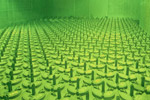Modern Waste
The conveniences of our modern world produce all different types of waste. Some waste is in invisible forms such as carbon dioxide or radiation, and other wastes are very noticeable as bright green algae or pink dyes. Electronic waste is a particular residue of our modern world and can be recycled given the proper care and attention.
 |
At this USA government site in Idaho, high-level nuclear waste is in dry storage. It was a by-product in the production of nuclear weapons during the era of the Cold War, and will remain radioactive for millions of years. » view large |
 |
A dye used as a preservative in the production of tofu at the plant in the background causes the waters of the Yellow River to turn pink. More than 600 million Chinese drink water contaminated with waste and 20 million people drink well water contaminated with high levels of radiation. » view large |
 |
Runoff of nitrogen-rich fertilizer from farmland causes a late summer algae bloom in Lake Erie, Ohio. Excess nitrogen in the water from fertilizer and manure runoff provides the nutrients for the algae to grow. It is the chlorophyll that gives the green algae its color. Some algae blooms also contain a neurotoxin called beta-Methylamino-L-alanine, or BMAA, which can pass the blood-brain barrier and has been implicated as a possible link to neurodegenerative diseases in humans such as Alzheimer’s Disease and Lou Gehrig Disease (ALS). » view large |
 |
At the Notore Fertilizer Plant in Port Harcourt, Nigeria, carbon dioxide is a waste product in the production of nitrogen fertilizer and is released in the flare to the atmosphere causing a greenhouse gas. » view large |
 |
In the late 19th century, Leadville, Colorado was booming. For almost 100 years, millions of ounces of gold and silver were recovered from mines surrounding the city. But eventually the ore ran out, and the soil and surface water in the mining district were heavily contaminated with lead, zinc and other heavy metals. Abandoned mining often have an outflow called acid mining drainage. Many years and millions of dollars have gone into mining superfund cleanups, and some areas polluted by hard rock mining will require water treatment in perpetuity. » view large |
 |
A tailings pond is filled with the waste from the recovery of bitumen in the oil sands near Fort McMurray, Alberta, Canada. There is a radar system to detect when birds are in the area. Then the peregrine falcon effigy pictured is activated with wings that move and predator sounds and a strobe light to scare away other migratory birds from landing on the toxic tailings pond. » view large |
 |
During a thunderstorm in a parking lot in Baltimore, Maryland, Polycyclic aromatic hydrocarbons or PAHs runoff into the Chesapeake Bay when it rains. PAHs come out of the tailpipes of vehicles and deposit on the pavement. They are a product of incomplete combustion of petroleum products. » view large |
 |
A young boy in Accra, Ghana. carries computer wires to be burned to for their copper. The computers are shipped here from Europe and the USA and some are reused but majority are dumped in Ghana. Poor workers often from the northern poorer region of Ghana do the work and sell the copper to buyers who send the metal to China or India. » view large |
 |
At MBA Polymers in Kematen, Austria, plastics from electronics are recycled in a sophisticated manner for reuse in injection and intrusion molding. In the laboratory each load is sampled and amount of plastic, wood, metals, etc. is determined. Plastics must be recycled if possible in the EU and incinerated if it is not possible to recycle. » view large |
Pictures from ‘Our beautiful, fragile world’, © Peter Essick

